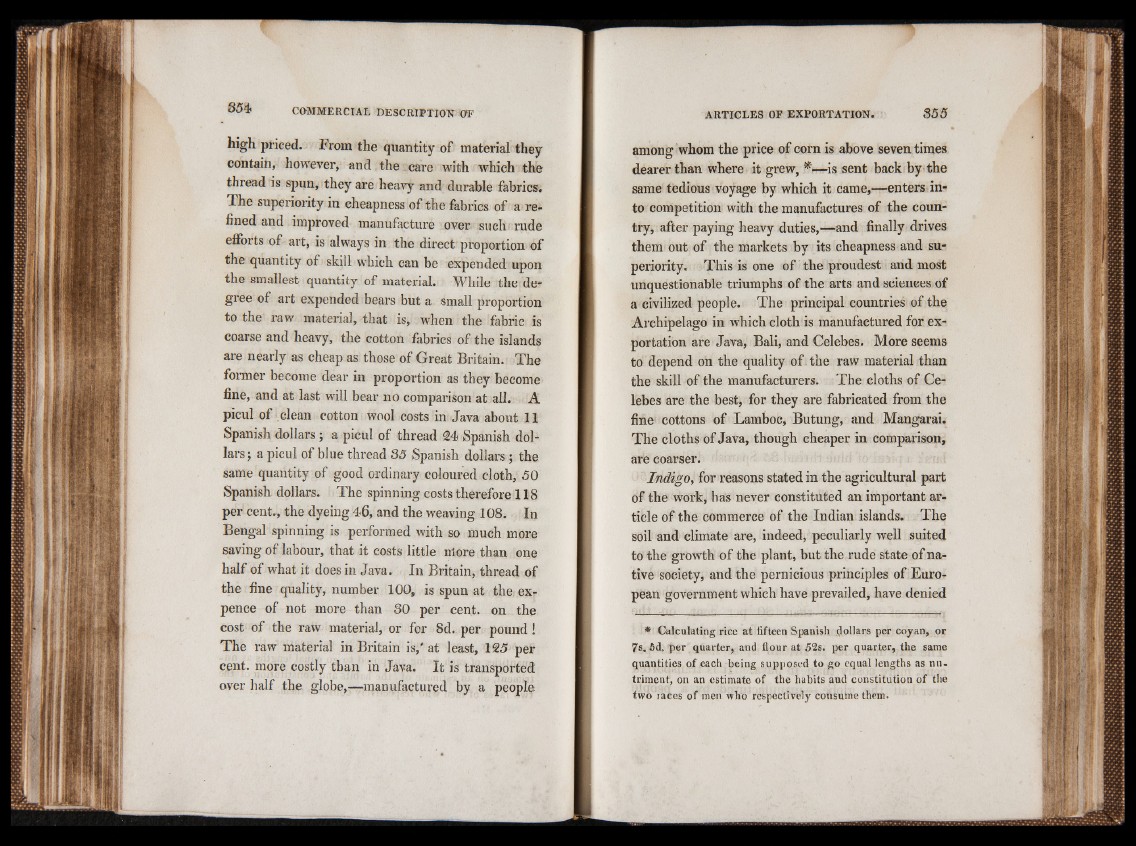
high priced. From the quantity of material they
contain, however, and the care with which the
thread is spun, they are heavy and durable fabrics;
The superiority in cheapness of the fabrics of a refined
and improved manufacture over such rude
efforts of art, is always in the direct proportion of
the quantity of skill which can be expended upon
the smallest quantity of material. While the degree
of art expended bears but a small proportion
to the raw material, that is, when the fabric is
coarse and heavy, the cotton fabrics of the islands
are nearly as cheap as those of Great Britain. The
former become dear in proportion as they become
fine, and at last will bear no comparison at all. A
picul of clean cotton wool costs in Java about 11
Spanish dollars; a picul of thread 24 Spanish dollars;
a picul of blue thread 35 Spanish dollars; the
same quantity of good ordinary coloured cloth, 50
Spanish dollars. The spinning costs therefore 118
per cent., the dyeing 46, and the weaving 108. In
Bengal spinning is performed with so much more
saving of labour, that it costs little more than one
half of what it does in Java. In Britain, thread of
the fine quality, number 100, is spun at the expence
of not more than SO per cent, on the
cost of the raw material, or for Sd. per pound!
The raw material in Britain is,' at least, 125 per
cent, more costly than in Java. It is transported
over half the globe,—manufactured by a people
among whom the price of corn is above seven times
dearer than where it grew, 0s—is sent back by the
same tedious voyage by which it came,—enters into
competition with the manufactures of the country,
after paying heavy duties,—and finally drives
them out of the markets by its cheapness and superiority.
This is one of the proudest and most
unquestionable triumphs of the arts and sciences of
a civilized people. The principal countries of the
Archipelago in which cloth is manufactured for exportation
are Java, Bali, and Celebes. More seems
to depend on the quality of the raw material than
the skill of the manufacturers. The cloths of Celebes
are the best, for they are fabricated from the
fine cottons of Lamboc, Butung, and Mangarai.
The cloths of Java, though cheaper in comparison,
are coarser.
Indigo, for reasons stated in the agricultural part
of the work, has never constituted an important article
of the commerce of the Indian islands. The
soil and climate are, indeed, peculiarly well suited
to the growth of the plant, but the rude state of native
society, and the pernicious principles of European
government which have prevailed, have denied
* Calculating rice at fifteen Spanish dollars per coyan, or
7s. 5d, per quarter, and flour at 52s. per quarter, the same
quantities of each being supposed to go equal lengths as nutriment,
on an estimate of the habits and constitution of the
two races of men ivho respectively consume them.